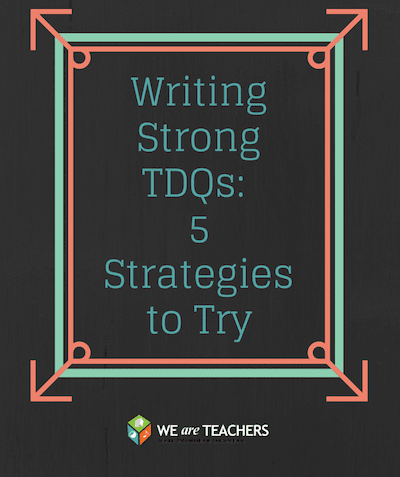Teaching Close Reading: Building Your Bank of Text Dependent Questions (TDQs)
This is the 3rd in a three-post series most TDQs. Read the other two posts here and here.
Nosotros've covered the nuts about close reading and text-dependent questions in our previous posts. Now it's time to upwardly our TDQ game: How can we come upward with practiced TDQs to use over again and again? Here are five question-planning strategies to try:
one. Build a Bank
Equally you build close reading lessons, you'll return to the aforementioned texts yr subsequently year, the same genre of text multiple times throughout the year, and you'll desire to use TDQs to elicit the same type of data from students lesson afterward lesson. Create a nautical chart of the types of TDQs you utilise oftentimes so y'all can tailor each to the text at hand. For example, questions nigh fiction structure:
- What do you lot learn near the setting? What information does the author give you?
- How do the characters in the story react to the setting?
- What do the characters say? What does that reveal about them?
And questions about nonfiction text features:
- What text structures does the author utilize? Were these good choices? Why or why not?
- What new information did you learn from this caption? How did the information in the captions add to the information in the passage?
(Discover more than TDQ examples here).
2. Scaffold TDQs
When TDQs start small—focused on details—and build to extract larger meanings and understandings, you lot're scaffolding the student experience. For case,
- Start with a question nearly the grapheme: What do you acquire about the character in this scene?
- And so, build to a question near narrative development: How does the principal graphic symbol treat other characters in this scene? Is this "in character" for this graphic symbol, why or why not?
- And, finally, ask questions nearly theme: How do the graphic symbol'south actions support the theme of freedom? What does the writer reveal about freedom through the character?

three. Accept Students Create TDQs
Eventually, y'all want students to be able to ask questions of text that go beyond "what happens adjacent?" When they can write TDQs, they can bulldoze their own experience with and word of text. To do this, take students find information or ideas in the text that they want to talk about. Then, have them write questions that send their peers to those sections of text.
4. Use TDQs to Tackle Differentiation
Identify the parts of the text that are most challenging, or that will claiming specific groups of students. Then, plan questions to help students chief those portions of text. For instance, if a small group needs back up effectually vocabulary, plan additional questions to aid them define central words from the text. (Check out this Colorin Colorado blog post for ideas relating to TDQs and ELLs in item.)
v. Apply TDQs to Tackle What's Not In that location
Once students are familiar with how to answer basic TDQs, accept them retrieve beyond the text to the options, information, and features that the author did non include. This creates pairs of TDQs, for example:
- TDQ: What information does the author reveal nigh the setting in the kickoff paragraphs? And not-TDQ: What information is not revealed? Why not?
- TDQ: What details were included in the passage? And non-TDQ: Why might the author choose to include the details he did? What details weren't included and why didn't he include those?
We want to hear your TDQ success stories! How have you used TDQs in your classroom?
Samantha Cleaver is a former special instruction instructor, electric current education writer. Her book nigh close reading, Every Reader, a Shut Reader, is coming out this summer from Rowman and Littlefield. Read more than at her blog: world wide web.cleaveronreading.wordpress.com .
Source: https://www.weareteachers.com/teaching-close-reading-building-your-bank-of-text-dependent-questions-tdqs/
0 Response to "Teaching Close Reading: Building Your Bank of Text Dependent Questions (TDQs)"
Post a Comment